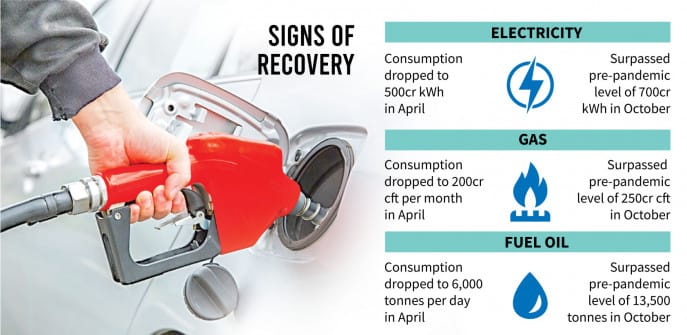Jebun Nesa Alo & Eyamin Sajid: “It is a positive sign if energy demands go back to the previous level, but other indicators have to be taken into account if we talk about economic recovery”
Bangladesh’s energy consumption, a key parameter linked to economic growth, has not only bounced back but also surpassed the pre-pandemic level in November.
This indicates a healthy sign of revival of transportation and business activities, but their outputs are yet to reach their full potential levels.
Consumptions of fuel oil, electricity, and gas dipped in April last year after the countrywide shutdown was enforced to contain the Covid-19 spread, and started picking up with the gradual reopening of businesses in May.
Fuel oil consumption that fell to 6,000 tonnes per day during that time has now reached 14,000 tonnes, up from an average consumption of 13,500 tonnes before the pandemic.
Use of electricity jumped to 700 crore kilowatt-hour (kWh) and gas use exceeded 250 crore cubic feet a month – both above their pre-pandemic levels, a finance ministry paper showed.
Exports saw a brief rebound before slowing down again, while domestic revenue posted modest growth in July-November. Consumer spending also marked a rise in the period.
Businesspeople, however, say they are still running below capacity and recovery is not just around the corner yet.
“Business was on track to recovery until October. But it has slowed down again once the second wave hit the western countries,” said Anwar-Ul-Alam Chowdhury Parvez, president of Bangladesh Chamber of Industries.
Industries are running at less than 25%-30% of their capacity, said Parvez, managing director of Evince Group, an apparel exporter.
A finance ministry presentation at the first meeting of the coordination council for the current fiscal year held on 31 December shows that the monthly use of electricity dropped to 500 crore kWh in April, which started to pick up pace from May when garment factories started to reopen after the one-month closure since the virus hit in March.
In July, electricity use returned to the pre-pandemic level at 700 crore kWh when export earnings started to rebound.
In October, electricity use surpassed the pre-pandemic level, according to the presentation paper.
The use of gas also shows the same trend reaching the pre-pandemic level.
In March, the monthly use of gas dropped to below 200 crore cubic feet soon after the country went in shutdown. The government allowed garment factories to reopen from May when gas use also started to turn around.
In July, gas use came back to the pre-pandemic level of 250 crore cubic feet.
In October, the monthly use of gas surpassed the pre-pandemic level, reaching above 250 crore cubic feet, which continued till November.
Md Siddiqur Rahman, vice-president of the Federation of Bangladesh Chambers of Commerce and Industry (FBCCI), said energy consumption has seen an upward move with the reopening of the public and private offices.
“The export sector is in dire straits as its destinations, the European Union and the United States, in particular, are still reeling under the onslaught of Covid-19,” he said.
Official data shows export earnings from two major export markets, the EU and the US, increased by 0.25% and 3.15% respectively in the July-November period of the current fiscal year over the same period last fiscal year.
In the current fiscal year until November, the export of home textile increased by 50.61% compared to that in the same period last year when exports of knitwear and jute products increased by 4.8% and 36.72% respectively.
Khandaker Enayetullah, general secretary of Dhaka Road Transport Owners Association, said the passenger transport business is at a loss due to a lower number of travellers in public transport. “All our buses, AC or non-AC, are running at a loss. We are not being able to recover even our operational costs,” said the transport sector leader and the owner of Ena Paribahan.
The stability in the money market and a boost in stock market indices also signal the restoration of business confidence.
DSEX, the benchmark index of Dhaka Stock Exchange (DSE), crossed the 5,800-mark on 12 January, the highest level in two years.
The daily transaction value has also doubled now compared to the pre-pandemic level, showing public confidence and the return of economic activities.
The implementation of stimulus packages worth Tk1.21 lakh crore, which was 4.34% of total GDP, gave a boost to the resumption of economic activities.
The government announced 21 stimulus packages for the recovery of pandemic-hit businesses. Of the total stimulus packages, Tk87,500 crore was disbursed through banks.
In August, banks started full-fledged disbursement of stimulus loans after the central bank relaxed some policy barriers.
The low-cost financing was a shot in the arm for businesses resulting in a 4.38% growth in the production index of medium and large industries when the growth was negative 1.51% in the same month of last year.
Jahangir Alam, former President of Bangladesh Textile Mills Association said the businesses have been improving gradually.
“As a basic raw material producing industry, our business is slowly recovering. It is better than that of May-June of last year. But it is not what it was in the pre-pandemic period,” he said.
Consumers are moving away from the Covid-induced behaviour– only going for the very essentials. Banks saw a 12% year-on-year growth in consumer loans in the July-September quarter, from a negative 3% growth in the preceding quarter, according to data from the Bangladesh Bank.
Dr Ahsan H Mansur, executive director of Policy Research Institute, said consumptions of fuel oil, gas and electricity reaching pre-pandemic levels alone do not mean that an early economic recovery can be expected now.
“It is a positive sign if energy demands go back to the previous level, but other indicators have to be taken into account if we talk about economic recovery,” he added.
Private sector credit growth is 8% against the target of 14.8%, while exports saw a negative growth and production remains stalled in all sectors, he pointed out.
Towfiqul Islam Khan, senior research fellow at the Centre for Policy Dialogue, said the return of fuel consumption to pre-pandemic levels means that public movement has increased and people are starting increased level of economic activities. However, it is difficult to say the economy has rebounded through this.
The country’s economy is now on the path to recovery. Some sectors have fully bounced back. But demand other than for essential goods and services is still low. The situation in several sectors such as personal care and tourism is still not good, he added.
Regarding the use of electricity, he said many businesses keep their shops open but sales are not up to the mark yet. Again, factories are now open, but production is still low, Towfiqul pointed out.

